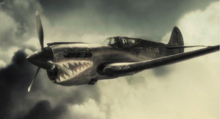
A heavily modified Curtiss P-40 Warhawk. Aside from serving as Joseph Sullivan's personal aircraft, the P-40 Warhawk appears to be the mainline fighter aircraft of the Flying Legion. Dex worked to enhance the aircraft's capabilities which included its submersible mode.
The features of the aircraft suggest that it was an entire rebuild, sharing few features with its real-life counterpart. One aspect of its design that remained the same was the inclusion of its 6 × 0.5 in (12.7 mm) M2 Browning machine guns in the wings.
The aircraft is frequently shown performing extremely sharp maneuvers far beyond the abilities of its real-life counterpart. It had been one of the most controversial fighter aircraft of the Second World War; vilified for being too slow, lacking in maneuverability, having too slow a climb rate, and being obsolete by European standards even before full-scale production.
Trivia[]
- In the original 6-minute short, Joseph Sullivan's aircraft was a Supermarine Spitfire.
- For scenes of the actors within the aircraft, the production team built an entire replica of the nose, fuselage, tail, and half of the wings.
- According to Kevin Conran in "Sky Captain and the Art of Tomorrow", the concept of including the aircraft's callsign "h11od" came to him in a dream. Initially the idea was dismissed by his brother, Kerry, but favored by Jude Law before being put into the production.
- Opinion was so low of the P-40 that it had even garnered a Congressional investigation under the "Senate Special Committee to Investigate the National Defense Program" (frequently referred to as the "Truman Committee" after its chairman, Missouri Senator Harry Truman).
- In the SCatWoT timeline, the Curtiss P-40 was apparently introduced earlier in the year 1939. P-40 prototypes did exist in limited capacities, namely the XP-40 which saw its first test flight on October 14th, 1938.
- In reality, P-40 Warhawks were designed as a single operator craft. However, a number of Lend-Lease P-40Es and Ks were modified by the Soviet Air Force as two seat photo reconnaissance aircraft. The "EF" designation was unofficially given to the aircraft by the Soviets, with the F standing for "Фото", the Russian word for photo.
- The "Shark Mouth" nose art pattern can be traced back as early as the First World War. Photographic evidence of the first "Shark Mouth" was on a German Roland C.II, a reconnaissance aircraft ironically referred to as "Walfisch" (Whale). This pattern fell into disuse in the Interwar Period but would reappear on several occasions during the Second World War. The Luftwaffe reintroduced this pattern on ZG 75 Messerschmitt 110s operating in Norway during the Battle of Britain. ZG 75 would carry over the shark mouth to Sicily and Iraq. The Royal Air Force No. 112 squadron, which had been reequipped with Curtiss P-40 Tomahawks in North Africa, created their own distinctive variation. This RAF pattern was copied and modified by the First American Volunteer Group (AVG), mercenary pilots hired by the Republic of China to help oppose the Japanese Invasion of China. The Shark Mouth pattern Joe Sullivan uses is based on the Flying Tigers pattern, with red highlighting the lower teeth.


